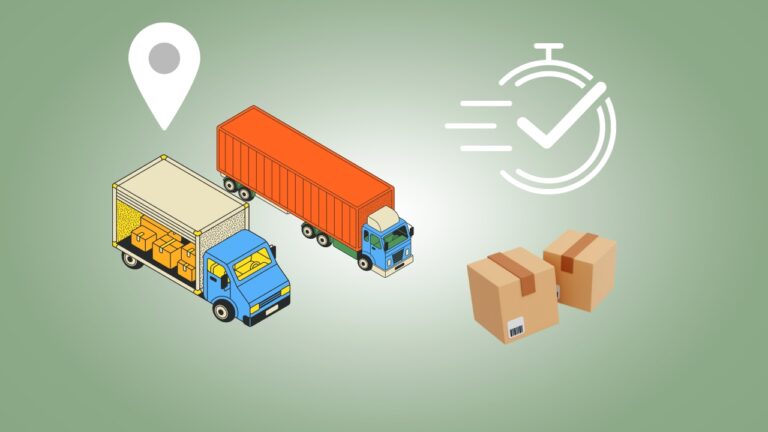‘In Transit’ is a critical term in the world of shipping and logistics, representing the phase when an item is moving from the sender to the recipient. It is a status that connects consumers, businesses, and logistics companies in a global dance of commerce. Understanding this term and its implications is essential in our increasingly interconnected world, where timely delivery is not just a convenience but often a necessity.
This blog delves into the meaning of ‘In Transit’, its relevance in the journey of a package, and provides insightful tips on estimating arrival times, catering to the curiosity and needs of both senders and recipients.
Understanding ‘In Transit’

‘In Transit’ is a term that indicates your package is actively moving towards its destination. It’s an essential status in the shipping process, marking the period between the package leaving the sender and arriving at the recipient.
This phase encompasses various stages of the journey, including departure from the initial facility, travel through various transit points, and potential stops at intermediary sorting facilities. Understanding this term is crucial for both senders and recipients as it provides a window into the journey of the shipment and helps in setting realistic expectations regarding delivery times.
Importance of Knowing ‘In Transit’
Knowing the ‘In Transit‘ status of a package is crucial for both senders and recipients. For senders, it confirms that their shipment has successfully left their premises and is on its way to the recipient. For recipients, it’s an assurance that their awaited item is making progress towards them.
This knowledge is particularly important in a world where timing can be everything – from receiving critical business inventory to getting that perfect birthday gift on time. Tracking this status can also help in planning, especially if someone needs to be available to receive the package upon arrival.
Tracking Your Shipment
Tracking a package is straightforward thanks to modern technology. Carriers provide a tracking number, a unique identifier for each shipment. By entering this number on the carrier’s website or app, you can access real-time updates on your package’s journey.
This system is incredibly valuable for monitoring your shipment’s progress and estimating its arrival time. Some carriers even offer notifications via email or text message, keeping you updated without the need to constantly check their website.
Common Carrier Services

Various carriers handle ‘In Transit’ shipments, each with their unique methods and technologies. Major players like USPS, FedEx, and UPS have sophisticated tracking systems that provide detailed updates. USPS, a government-run service, is known for its widespread reach.
FedEx and UPS, on the other hand, are private companies known for speed and additional services. Understanding these carriers’ different approaches to handling shipments can offer insights into the expected delivery times and tracking accuracy.
Estimating Arrival Time
Estimating the arrival time of your package can be done by closely monitoring the tracking information provided by the carrier. Most carriers offer an estimated delivery date, which is usually quite accurate.
However, keep in mind that this is an estimate and can be affected by various factors. Regularly checking the tracking updates can give you a better idea of when your package will arrive, especially as it gets closer to the destination.
Factors Affecting Arrival Time
Several external factors can influence the delivery time of your package. Weather conditions, such as severe storms or heavy snowfall, can delay transit. Holidays often lead to increased package volume, slowing down the process.
Additionally, the package’s destination plays a role; deliveries to remote or hard-to-reach areas might take longer. Being aware of these factors can help in setting realistic expectations regarding delivery times.
Reading Tracking Updates
![]()
Interpreting tracking updates like ‘Out for Delivery’, ‘Arrival at Sorting Facility’, and ‘In Transit’ is key to understanding where your package is. ‘Out for Delivery’ means it’s on the final leg of its journey, while ‘Arrival at Sorting Facility’ indicates it’s being processed for the next stage of transit. Familiarizing yourself with these terms can provide a clearer picture of your package’s progress and help in estimating its arrival time more accurately.
Contacting the Carrier
If you need more precise information about your package’s arrival, don’t hesitate to contact the carrier. Customer service can often provide more details than what’s available online. This step is vital, especially in scenarios where the tracking information is unclear or hasn’t been updated for an extended period.
Each carrier has different protocols for handling inquiries, but they generally require your tracking number. Be prepared to provide additional details like your shipping address or the nature of your item. Efficient communication with the carrier can be a decisive factor in timely receiving your package and resolving any uncertainties.
Managing Expectations
It’s important to manage your expectations when waiting for a package. Delays can happen, and sometimes they’re beyond the control of the carrier. Weather disruptions, logistical challenges, and unprecedented volumes of shipments can all contribute to delays.
Maintaining patience and understanding that the logistics involved in shipping are complex can help in dealing with any delays or issues that might arise. A good practice is to plan for a buffer in delivery time, especially if the item is needed by a specific date. This proactive approach can alleviate the stress associated with waiting for important shipments.
Lost or Delayed Shipments

If your package is significantly delayed or appears to be lost, the first step is to contact the carrier. They can initiate a search for your package or provide additional information. Keep all your shipping documents and tracking numbers handy, as these will be crucial in resolving any issues with your shipment.
The carrier might ask for a detailed description of the package or its contents, which can help them in locating it. In cases of lost shipments, understanding the carrier’s policies on lost goods and insurance claims is vital. It’s also beneficial to be aware of your rights as a consumer in such situations, as different countries have varying regulations regarding shipping liabilities.
Conclusion
‘In Transit’ is a term that signifies a package’s journey from sender to recipient. Understanding this term, tracking your shipment, and being aware of factors affecting delivery times can enhance your shipping experience.
Remember, while carriers strive to deliver on time, patience is key. Stay informed, realistic, and proactive in tracking your packages to ensure a smooth delivery process.
Related Posts:
- When is the Best Time to Visit Egypt? Insider Tips…
- Can Time of Day or Day of the Week Impact Your Wins?…
- Brain Boosters: Enhancing Cognitive Processing…
- How Long Does CBD Oil Stay in Your System? 2024 Tips…
- What Is Normal Ovary Size and How Does It Affect Pregnancy
- How Much Does Mold Testing Cost? 3 Tips for…











